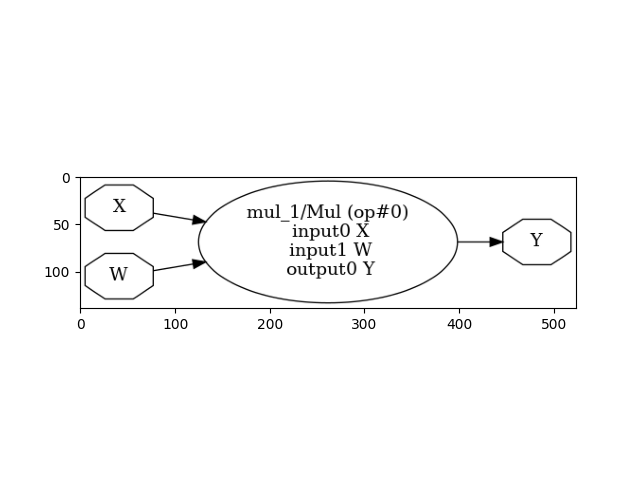Note
Click here to download the full example code
Draw a pipeline¶
There is no other way to look into one model stored in ONNX format than looking into its node with onnx. This example demonstrates how to draw a model and to retrieve it in json format.
Retrieve a model in JSON format¶
That’s the most simple way.
from onnxruntime.datasets import get_example
example1 = get_example("mul_1.onnx")
import onnx
model = onnx.load(example1) # model is a ModelProto protobuf message
print(model)
Out:
ir_version: 3
producer_name: "chenta"
graph {
node {
input: "X"
input: "W"
output: "Y"
name: "mul_1"
op_type: "Mul"
}
name: "mul test"
initializer {
dims: 3
dims: 2
data_type: 1
float_data: 1.0
float_data: 2.0
float_data: 3.0
float_data: 4.0
float_data: 5.0
float_data: 6.0
name: "W"
}
input {
name: "X"
type {
tensor_type {
elem_type: 1
shape {
dim {
dim_value: 3
}
dim {
dim_value: 2
}
}
}
}
}
output {
name: "Y"
type {
tensor_type {
elem_type: 1
shape {
dim {
dim_value: 3
}
dim {
dim_value: 2
}
}
}
}
}
}
opset_import {
domain: ""
version: 7
}
Draw a model with ONNX¶
We use net_drawer.py included in onnx package. We use onnx to load the model in a different way than before.
from onnx import ModelProto
model = ModelProto()
with open(example1, 'rb') as fid:
content = fid.read()
model.ParseFromString(content)
We convert it into a graph.
from onnx.tools.net_drawer import GetPydotGraph, GetOpNodeProducer
pydot_graph = GetPydotGraph(model.graph, name=model.graph.name, rankdir="LR",
node_producer=GetOpNodeProducer("docstring"))
pydot_graph.write_dot("graph.dot")
Then into an image
import os
os.system('dot -O -Tpng graph.dot')
Out:
0
Which we display…
import matplotlib.pyplot as plt
image = plt.imread("graph.dot.png")
plt.imshow(image)

Out:
<matplotlib.image.AxesImage object at 0x7feafe274ac0>
Total running time of the script: ( 0 minutes 0.196 seconds)